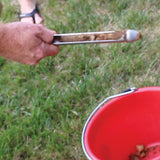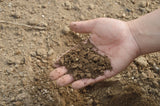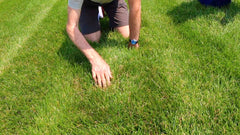Soil pH and Lime
Soil testing takes the guesswork out of gardening and lawn care:
A soil test can help you diagnose plant and lawn problems and determine what type of plants to grow.
- Lab results provide fertilizer/soil amendment recommendations unique to your lawn or garden.
- Soil testing saves money that might otherwise be spent on unneeded products such as lime and fertilizer.
- Soil testing helps protect streams, rivers, and the Chesapeake Bay from excess nutrients.
How Soil pH Affects Fertility:

The soil’s pH is important because it influences a plant’s ability to absorb nutrients from the soil. No amount of fertilizer can make plants grow in soil that has the wrong pH.
- The pH scale ranges from 0 to 14. A pH of 7 is neutral. Soils with pH levels below 7.0 are acidic and soils with pH levels above 7.0 are alkaline or basic. It is a logarithmic scale: a soil pH of 6.0 is ten times more acidic than a soil pH of 7.0.
- Some plants prefer acidic soils and others grow best in alkaline soils.
- Most garden and landscape plants grow best in soils with a pH of 5.5–7.0.
- Lawns grow best in soil that is neutral to slightly acidic (between 6.3 and 6.8).
- Acid-loving plants like azaleas, rhododendrons, and blueberries grow best in soils with a pH of 4.5 to 5.5.
- The pH level for vegetable gardens should be in the 6.2-7.0 range. Soil pH can be lowered by adding sulfur or raised by adding limestone based on your soil test recommendations.

Lime, which is also known as calcium carbonate or limestone, can be beneficial to the lawn. It helps to neutralize the acidity in soil, and it raises the pH to a desired slightly acidic level, which is where most turf grasses grow best. Testing the soil and following guidelines for applying lime will ensure that you are applying the lime in the best way possible to benefit your lawn.
For most types of grass, the ideal pH level for your soil is between 6.2 and 7.0. This is considered slightly acidic. Some grasses do better when the pH is higher, and others do well when it is lower. For example, Kentucky bluegrass, tall fescue, ryegrass, and fescues are cool-season grasses and they do better with a slightly higher pH, or closer to neutral pH. On the other hand, warm-season grasses prefer a more acidic pH, which is lower. When the pH of soil becomes too acidic, the nutrients that grasses depend on for proper growth are no longer available for the grass to grow properly. This includes nitrogen, phosphorus, potassium, calcium, and micronutrients. Applying lime helps to increase the pH of the soil and make those nutrients available to your lawn.
Testing Your Soil pH Level:
You can buy do-it-yourself soil pH test kits or soil pH meters to find out whether you need to add lime, but they will not recommend how much to add. The Mill offers soil testing services. If you bring a sample of your soil to The Mill, we can prepare it for lab analysis. The cost is $20 and will take about 2 weeks to get results and recommendations. The Mill also offers a Lawn Consultation service for $75. This includes a scheduled lawn inspection with a Mill specialist collecting soil samples and putting together a multi-season plan for you. More information and soil testing instructions are at www.themillstores.com.
It can take 8 months for lime to break down and change the pH level of your soil. The best time to test your soil is in the spring, just as the soil begins to get warm. You can apply lime in the spring or fall. During the fall and winter months, there is a cycle of freezing and thawing along with plenty of rain and snow. These events will help to break down the lime so that it can work to raise the pH level of the soil. Just remember that you should never apply lime to a lawn when it is dormant or stressed. Some processed limes act more quickly in raising the soil pH. Solu-Cal is a brand that adjusts pH in 1 month. Quick-acting lime does not last as long at holding soil pH in desirable ranges as pulverized lime, but is usually more beneficial for soil and economical over time due to additional microbials and humics included in Solu-Cal formulas.
Types and Forms of Lime:
There are two types of lime: calcitic lime and dolomitic lime.
Calcitic lime is high in calcium, and it is better for the lawn because calcium benefits plants. There are multiple forms of calcitic lime, including the following:- Agricultural ground limestone
- Pulverized limestone
- Pelletized limestone
- Solu-Cal High Cal and Solu-Cal Hi-Mag
Calcitic Versus Dolomitic Lime:
- Lime that is calcium carbonate is a calcitic lime. It is high calcium lime. Calcitic lime is the preferred type as calcium is a stronger neutralizer of pH and provides more benefits for soil and plants because it is usually more deficient.
- Dolomitic lime contains some cal
cium and a high level of magnesium. Dolomitic lime benefits soil that is lacking magnesium. Magnesium has some buffering ability too but is not as lacking or crucial to plant health as calcium. Soil tests are the only way to know which lime is better to use.

Forms of Lime:
Ag Lime: This form of lime is agricultural lime, which is recommended for agricultural uses rather than a garden. It is coarse limestone, and it takes a very long time to break down. It should be used in large areas where crops are planted. It can be calcitic or dolomitic.
Pulverized Lime: Pulverized limestone is a powdery form that is made by crushing limestone rock. The benefit is that it breaks down very quickly and raises the pH level. However, it is very dusty and difficult to transport.
Pelleted Lime: To solve the problem of transporting pulverized lime, a pelleted form was developed. There are also enhanced forms of pelletized lime that may have polymers, organic acids, and micronutrients added. Pelleted lime is easier to transport and spread. If it is enhanced, it can help to keep nutrients in the soil where they are needed. However, it is important to buy a high-quality pelleted lime to ensure that it does its job.
Solu-Cal: Enhanced lime that works in 4 to 6 weeks and 1 bag of Solu-Cal equals 4 bags of regular Lime, allowing you to handle less material with faster results for about the same price!
Both pelleted and pulverized limestone change the pH of the soil quickly, however, pelletized limestone is easier and less dusty to apply. The soil test results will recommend how many pounds of pure calcium carbonate to apply.
Benefits to applying lime include:
- Balances the pH of the soil.
- Provides calcium and magnesium so that grass can grow and survive stressful situations such as drought, extreme temperatures, snow, and excessive rainfall.
- Adds nutrients to the soil.
- Helps grass grow stronger roots.
- Boosts the effectiveness of herbicides and fertilizers.
- Helps new seed or sod to take root and grow.
- Benefits beneficial microorganisms that are in the soil.
Calculating Lime per Acre
It is important to have the soil tested to determine the exact needs of your soil. Once the test results are in, the Mill will tell you how much lime you need to add per acre. In general, it takes 1.2 tons of agricultural lime per acre to raise the pH of a loam soil by one point. It is half that for sandy soil and almost double for clay soil. You need to know the composition of your soil as well as the pH level and it is best to have a test result provided by The Mill to find out the exact recommendation.
In general, 1.2 tons of lime is the equivalent of 48 standard 50-pound bags of ground agricultural limestone. This is what it would take to raise the pH of loam soil from 5.5 to 6.5. Solu-Cal in the same situation, would only need 12 bags applied to get the same results!

























